I selected my track bike for a couple of reasons: I wanted something that fit my riding goals and would be a solid platform; secondly, I wanted a bike that had a respectable amount of data gathering capabilities. For the purpose of my own riding development, I've gone with a nearly stock Triumph Daytona 765 moto2. It competes with a well-built 600 supersport in terms of power. I went with Triumph because I have a good relationship with the local dealership, I'd already had 3 other Triumph triples so I knew the platform. Also highly valuable is the fact that the Daytona shares the basic engine and a lot of parts with the 2018+ Street Triple 765 RS (which is one of my street bikes). They both use the same wheels and brake rotors so on cold days I can pull the DOT tires/wheels from the Street Triple and put them on the Daytona. Likewise, if the Daytona is being serviced, I can take the Street Triple out and it's not too dissimilar (although the handlebars v clip-ons alone makes a very significant difference in riding experience).
AiM released an ECU profile for the 2013+ Daytona several years ago that works with both of my Triumphs so that's another valuable consideration. With that profile, I'm able to collect throttle position, gear position, engine RPM, rear-wheel speed, and coolant temperature. I also have the necessary software and hardware to reset the service intervals. Since the 2013 and newer Daytona 675R, the bikes have come standard with high-spec Brembo brakes, Öhlins suspension, steel braided brake lines, and a lot of other bits that would be very expensive to add to most supersports. I also like the power delivery of the Triumph triples.
In terms of AiM equipment and additional sensors, I use the following:
EVO4s data logger
GS Dash mounted to the steering stem
SmartyCam HD GP v3, controller mounted to the right of the fairing stay, set to 60fps at 1080p
SD card memory module
shift light module
CAN expansion hub
GPS09 GPS module mounted to the tail (best reception)
2000psi brake pressure sensor on the front and rear brake lines
150mm & 75mm suspension potentiometers (added 2022)
i2M CAN bus tire pressure monitoring system (TPMS), added late 2023
GripOne IMU, added late 2023
AiM slim suspension potentiometers (pots), 150mm front, 75mm rear
The bike has the following parts/protection/modifications:
Arrow titanium slip-on from the 2013-17 DaytonaBodis full exhaust, stainless steel for the 2013-17 Daytona
Attack Rearsets for 2013-17 with a Woodcraft race-shift linkage (the Attack shift linkage had interference with the swingarm)
Flashed ECU by 2 Wheel Dynoworks using TuneECU
Venturi velocity stacks
Ohlins FKR cartridge kit with 130mm travel modification (MC Tech)
LSL sprocket guard
Translogic quickshifter/blipper sensor with OEM connection (reverse wired for the Woodcraft shift linkage and race/GP shift)
MotoXPricambi bodywork (2013+ D675/Street Triple)
Karma modified RAM mounts in the mirror mount location for camera(s)
Puig double bubble windscreen
KurveyGirl titanium bolts (caliper, banjos, some others)
Stahlbus bleeders on the front master cylinder and front calipers
KurveyGirl clips for race requirements, safety-wired
Brembo RCS17 Corsa Corta master cylinder
TWM Remote master cylinder span adjuster
Vesrah RJL-XX front pads
Racetorx thumb brake kit (retaining foot brake)
Woodcraft 1" rise clip-ons & XL bars (I drilled for the switchgear holes, and removed original bar-end weights and mounts)
Driven Halo keyless gas cap (2013+ D675/Street Triple)
EvoTech radiator & header guards (2013+ D675)
Stompgrip tank grips & pad (2013+ D675/Street Triple)
R&G carbon tank sliders (2013+ D675/Street Triple)
Western Powersports Lithium battery
Braketech stainless steel ventilated brake pistons (front only)
Pro-Bolt titanium drilled and magnetic drain plug
Triumph front fork sliders (3rd gen D675)
T-Rex magnetic rear axle sliders (2013+ D675/Street Triple)ThreeD 520 O-ring chain conversion w/ 16T front and assorted rear sprockets
Woodcraft frame sliders (behind the fairing)
Lightech chain adjusters (TETR002ORO)L74 quick-change rear kit with rear ABS bypass (rear only), includes HEL captive underslung rear caliper (2023)
Fast Frank pull-cup front spindle
Woodcraft brake lever guard
MotoHolders fairing stay for Gen 3 Daytona, street version (modified to fit the 2020 dash)
Karma aluminum brackets for AiM gear
Woodcraft engine case protection (the set spec'd for the 2013+ D675)
SmartMoto evaporative canister elimination kit (the kit spec'd for the 2017+ Street Triple)
SmartMoto sidestand switch bypass
SmartMoto block off plates
AMC-Carbon swingarm protector (spec'd for the 2013+ D675)
Spare Daytona wheels & brakes from a 3rd gen bike
MC Tech suspension tuning w/ re-valving & re-spring
UKRS linear rear suspension link with adjustable ride height (2013+ D675/Street Triple)
Captive wheel spacers (f&r)
Triumph OEM tank & fuel pump from 2013 Daytona (all the stock bodywork is wrapped up and stored)
Bursig lift
Motul 10w/40 300v
2022-03-28 Update
I just got the bike back from its annual suspension service (MC Tech, Mike Canfield), and while with Mike, he installed Woodcraft clip-on clamps with a 1" rise which will give me some adjustability for ergonomics, better mounting of the regulator/rectifier, and AiM suspension potentiometers. Mike comes up with creative and elegant solutions and this project was no exception. Mike tracked down a special bolt for the front lower mount that replaces one of the bolts in the ABS sensor mount that has a female receiver for the stud on the front potentiometer and an EvolTech upper bracket. The front pot is a 150mm AiM unit and the rear 75mm.
Upon bringing it home, the Daytona got fresh Motul oil and Triumph filter, and new Vesrah RJL-XX front brake pads, and since the oil was out, I installed the last of the WoodCraft engine covers. I also safety wired the engine oil parts. I don't plan to race this bike but I want to have it ready to go in case I did decide to race it so I'm slowly making the preparations when I'm service the respective area.
2022-07-13 Update
I've been working with a custom CAN programmer and between the two of us, we have been able to uncover additional channels in the CAN stream. Unfortunately it doesn't appear to contain any brake pressure, activation, or ABS data, although it contains some other things that will be very useful: throttle map, TC mode, TC activation, throttle position at the throttle bodies AND throttle position at the hand, front and rear wheel speed, and some other mystery channels that we've not yet figured out (possibly fuel level, odometer/tripmeter, etc. I'm updating the list of channels that we have working correctly because some of these, namely the wheel speed, are not quite there.
Not that I use the rear brake in track riding, but I did add a rear brake pressure sensor. This is mostly because if I have a reference rider take my bike out, I want to be able to capture their use, if any, of the rear brake.
Data Acquisition Measures
ECU:
RPM
Gear Position
Hand throttle position
Throttle body position
Front-wheel speed
Rear-wheel speed
Coolant temperature
Intake air temperature
Ignition advance
TC mode
TC intervention
Map mode
Analog channels:
Front brake pressure
Rear brake pressure
Front suspension travel
Rear suspension travel
AiM EVO4s channels:
6-way gyro
Accelerometer
GPS (bike position and speed)
i2M TPMW
Front & rear tire pressure and temperatures (internal)
GripOne IMU
Native lean angle output
2023-01-11 Update
The Daytona went off to its annual MC Tech visit a couple of months ago. After each season MC Tech refreshes the suspension and makes adjustments/changes as deemed appropriate by myself and my primary riding coach. During the course of 2022, my coach rode the Daytona a couple of times and we made some adjustments, the first being some ergonomics and then raising the front of the bike by dropping the forks a few mm through the triple clamp. One thing that my riding coach noticed in riding the Daytona was that he didn't feel like he could use the brakes the way he wanted because of the sensation of the bike being too high in the rear (and hence part of the reason for raising the front of the bike). This was high on the list of things for MC Tech to review. Also on the list is the installation of the full Bodis exhaust, a baseline dyno measurement, and a tune post-exhaust installation. Before dropping the bike off, I had a quick-release rear axle + captive rear caliper kit installed. Since I'm going through rears quite a bit faster, this seemed like a logical upgrade. That wasn't without challenge though as the captive spacer wasn't tall/wide enough so when the rear axle was torqued down it was pinching the top of the sprocket carrier and resulted in drag. The solution was 14mm tall (originals are 12mm) captive spacers and that mostly rectified things but MC Tech noticed that the rear brake was slightly off between the pads and the disk rotor so the most elegant solution was to grind off a couple of mm of rear brake pad. This is something I'll have to remember if/when I change rear brake pads but since I personally don't use the rear brake at all, at least at this point, I don't foresee this being an issue. The kit bypasses the rear ABS circuit which doesn't matter much to me since I pretty much never use the rear brake. I ordered up some slick little bung bolts from AF1 Racing while I was ordering Tuono parts. Mike said the clearance to the radiator hose with the Bodis headers is a bit tight but I'm sure he'll sort that out.
Yesterday I got a call from Mike and he said that there is the option of the FKR Öhlins cartridge kit available for my forks (the stock Öhlins forks on the bike have their entry-level NIX30 kit). Short of replacing the entire fork assembly, this is the most significant upgrade. I pinged my riding coach and he said to do it so Mike is ordering them up. I asked Mike what to expect as a result of the upgraded cartridge and he said it should result in greater front-end confidence.
This will be an expensive visit to MC Tech but the bike continues to evolve and get better each year.

2023-10-31 Update
As I wrote in a separate post, the cylinder head gasket started leaking on the Daytona in my last couple of days at the Ridge in September. Those were my last days there so I brought it to my mechanic, P&M in Petaluma. Once apart, they confirmed the head gasket and we sent the head next door to Engine Dynamics for a blueprint and reinforcement. It's still not back yet as we've been waiting on parts.
I did receive the i2M CAN TPMS receiver and sensors. Mitch Minton coded up some additional CAN bus code so that the custom Triumph AiM profile he built for me will carry that.
I'm expecting a GripOne IMU from Italy in the next couple of weeks. This IMU is capable of a lot of things, particularly if I ever went with an open 3rd party ECU and harness (probably not) but the key thing it does that I'm after is native lean angle output. I'll work with Mitch again to get that added to the existing CAN protocol and then I'll be able to output that directly into the AiM data stream, along with feeding it to the SmartyCam for automatic overlays including lean angle, just like the Tuono (which has an on-board IMU already).
2023-12-01 Update
Now that the bike is back with its fresh and improved engine, I've been able to implement some of the other data upgrades. There are two big ones here:
Tire Pressure Monitoring System (TPMS) - since I have a total of 5 wheels for the bike, I wanted 5 TPMS units and had those installed into each of the 5 wheels and coded them up. I used the i2M TPMS-CAN version. This has the TPMS transmitters mounted inside each of the wheels and the receiver has power, ground, and CAN high and low connections. i2M provides the coding details and just like the bike, it uses a 500 kbps bus speed. This was fairly easy to implement. I did have to wait a couple of months to receive the coding cable which is not simply a generic USB connector but it has a chip that has a native Windows 10/11 driver and this is necessary to tell the receiver what frequency identifiers to listen for and register as either front or rear.
IMU - The Daytona, unlike the 2023/24+ version of the Triumph Street Triple, does not have a native IMU (which provides more granular TC and lean-sensitive ABS on the newest Street Triples). The part that I was interested in was being able to add native lean angle output to the AiM data stream, and to be able to implement that into the AiM SmartyCam (v3) overlay. I found the GripOne IMU. GripOne is largely Diego Gubellini, a former data engineer for several MotoGP teams. This device has an accelerometer in it and natively outputs roll (lean) and pitch angle (longitudinal, meaning it will show when wheelies or stoppies occur). I couldn't find any other way to natively output accurate pitch and roll angle data into the data stream without doing math channels in RS3 so I ordered the GripOne IMU. The kit isn't quite as complete as what most consumers are looking for. It arrives in clamshell packaging and doesn't include a terminated harness, though it includes one plug. The documentation is so-so and I wrote up some modifications that I suggested they implement, as well as in the coding software. I'm only using the IMU to provide direct pitch and roll angle data, however, it's capable of a lot more than that. If you have a programmable ECU, it has provisions to be able to use it for IMU-based TC/WC and lean-angle sensitive ABS, as well as lean-sensitive lighting. The native bus speed is 1 Mbps, which caused me a great deal of headaches in trying to get it to talk on the bike's 500 kbps bus. Gratefully GripOne built a 500 kbps firmware package that I installed and was able to get working in short order.
I installed a Racetorx thumb brake for the rear. This thumb brake allows you to retain the stock foot-operated master cylinder along with the thumb-operated master cylinder. You can't use both simultaneously but you can use one or the other. The installation wasn't bad. I had room because I use the Woodcraft XL bars and moved a couple of other things slightly and there is a good range of adjustment on the thumb brake. Bleeding it is a bear, however. I've spent more time than I care to admit in trying to get a good bleed on it. I'll give it another go tonight. The basic installation was pretty straightforward. I don't love the reservoir tube so I'll likely install a full-fledged reservoir. Since the kit eliminates the normal rear brake reservoir, I may re-use it for the thumb brake but mount it up front with a Ladybird bendable bracket. There is not any documentation included so you'll want to search the 'tube for a tutorial.
In an effort to reduce the brake fade I get on faster laps at hard-braking tracks, I had the stock caliper pistons replaced with Braketech ventilated stainless steel pistons. If this doesn't sort out the brake fade, I'll look into adding brake ducts like I did on the Tuono V4. There isn't an OEM Triumph option but I found a company that makes some that look interesting: Strauss makes some that look pretty good. The step past that is the Castrol magic (and insanely expensive) brake fluid and beyond that, a 320mm brake rotor kit with thicker rotors. This would add weight and is big money but brake fade kind of bites.
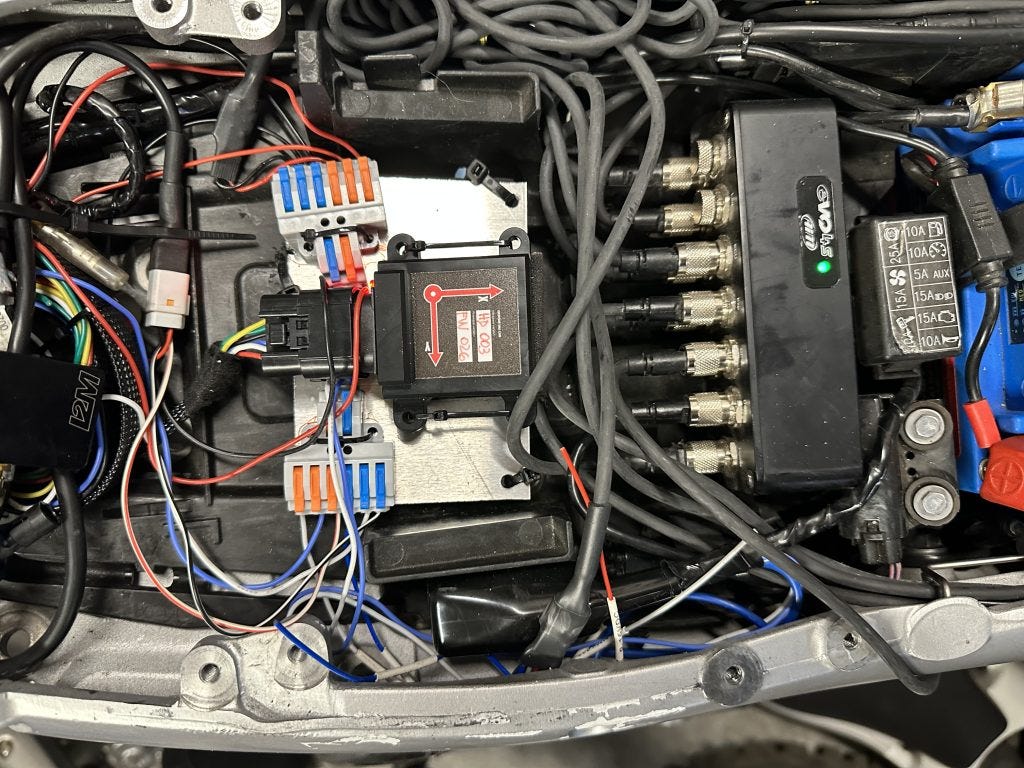

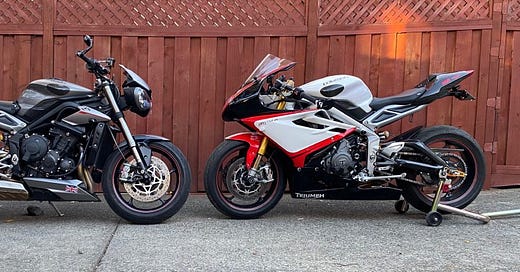


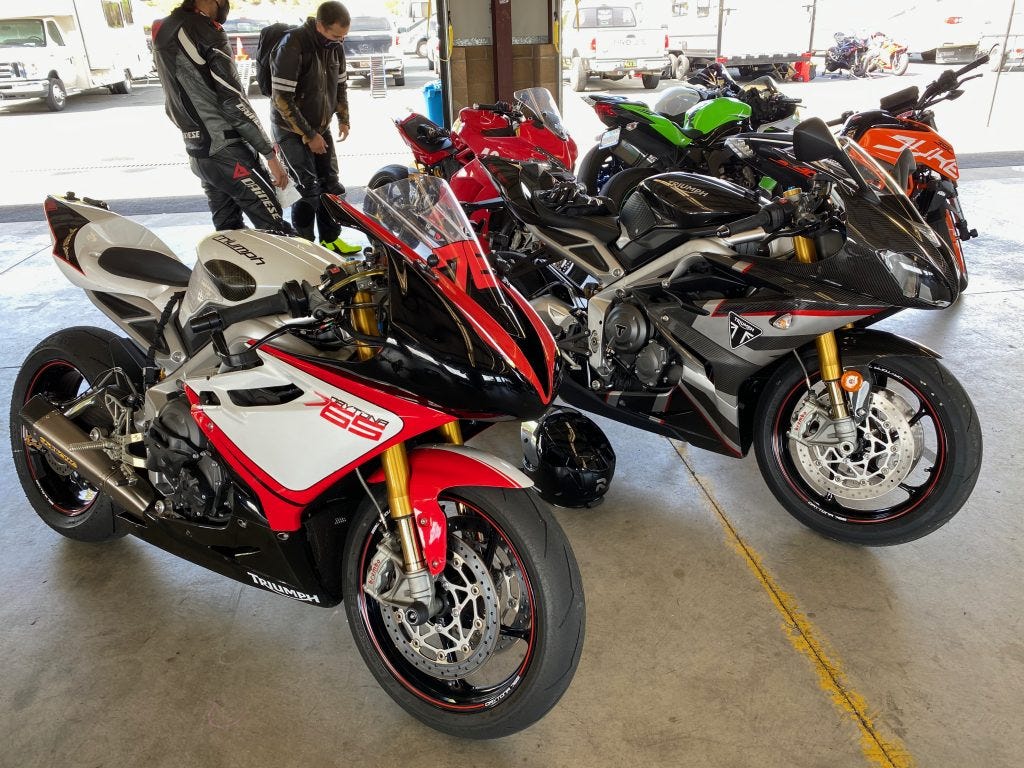
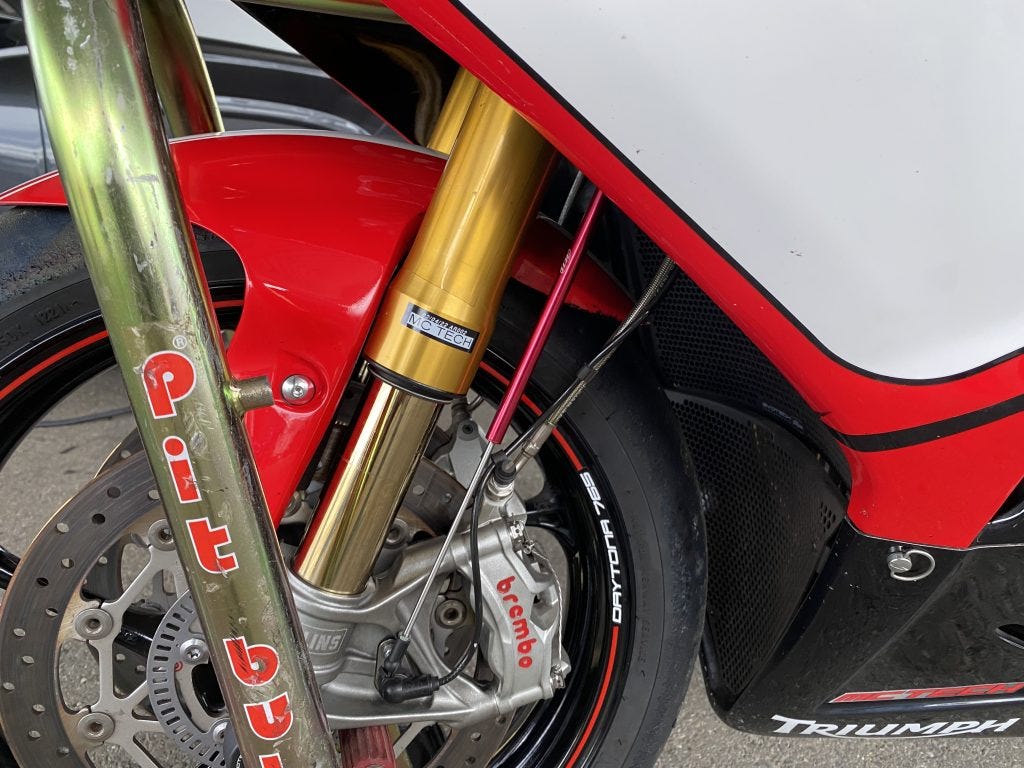
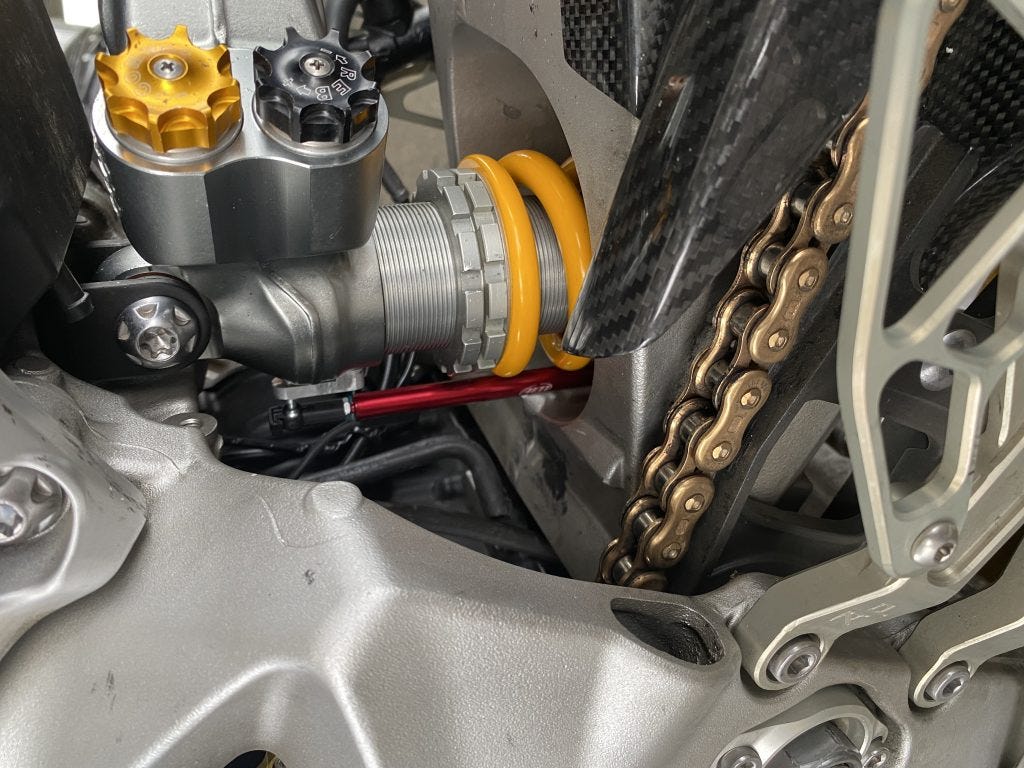

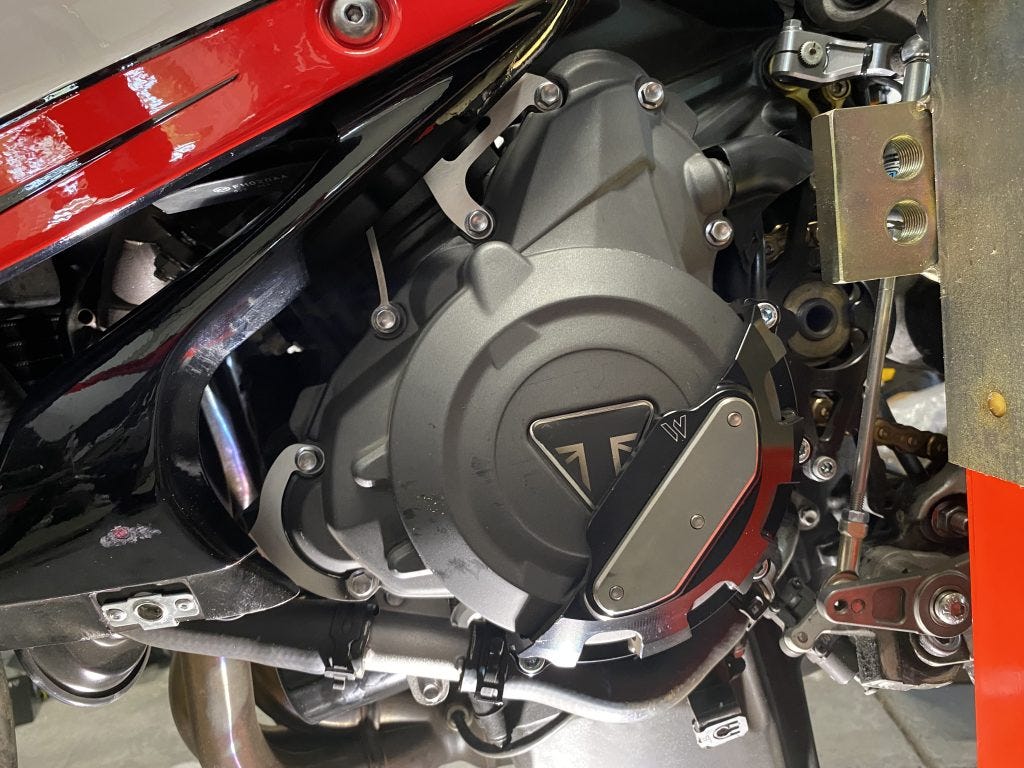
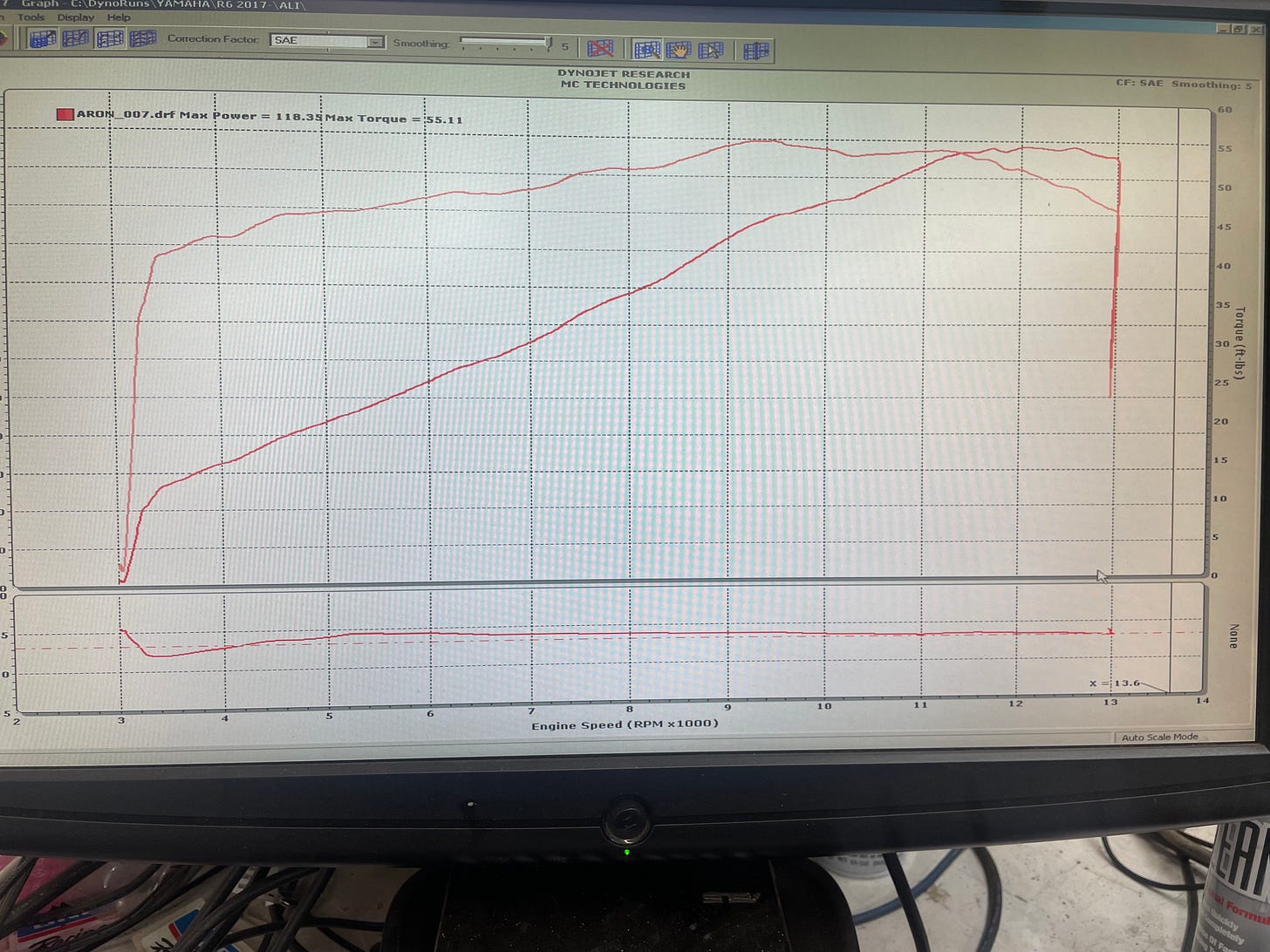



Hello,
I saw your blogpost of 2023-06-17 with the expanded solo 2 DL setup and I was wondering if adding the i2M TPMS-CAN system to it would be possible instead of the camera setup you included? Or perhaps even ontop of the camera slot if the 4 way data hub from aim gets used?
I have been doing some research on how to expand upon my solo 2 DL setup and your setup in that blogpost is a very good example of what I would like accomplish with ideally ontop of it also the TPMS.